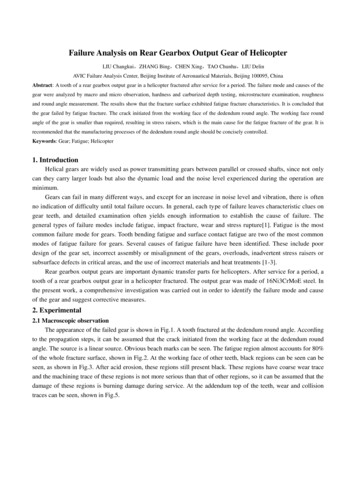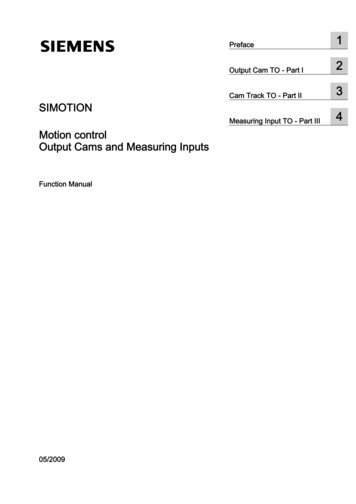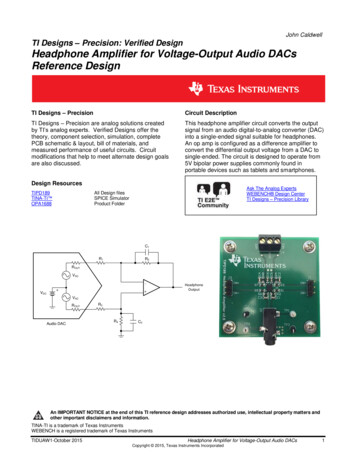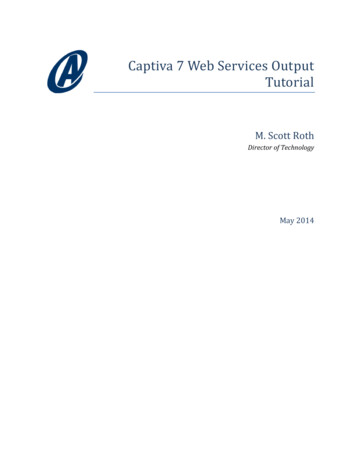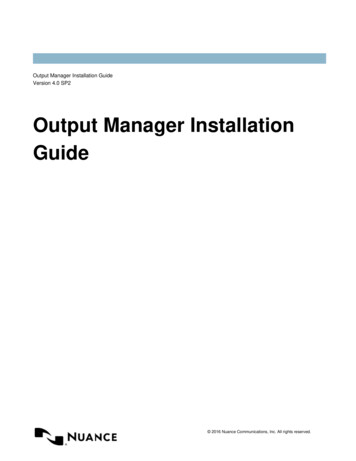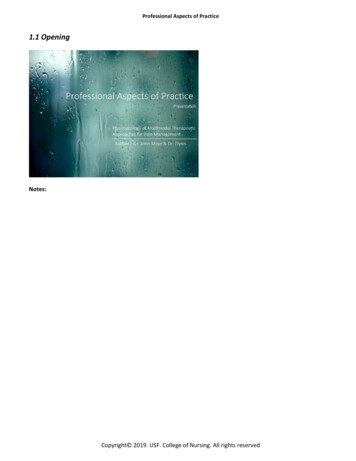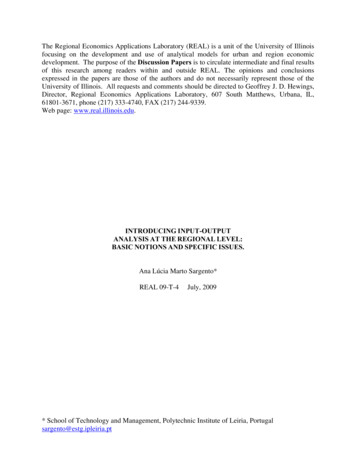
Transcription
The Regional Economics Applications Laboratory (REAL) is a unit of the University of Illinoisfocusing on the development and use of analytical models for urban and region economicdevelopment. The purpose of the Discussion Papers is to circulate intermediate and final resultsof this research among readers within and outside REAL. The opinions and conclusionsexpressed in the papers are those of the authors and do not necessarily represent those of theUniversity of Illinois. All requests and comments should be directed to Geoffrey J. D. Hewings,Director, Regional Economics Applications Laboratory, 607 South Matthews, Urbana, IL,61801-3671, phone (217) 333-4740, FAX (217) 244-9339.Web page: www.real.illinois.edu.INTRODUCING INPUT-OUTPUTANALYSIS AT THE REGIONAL LEVEL:BASIC NOTIONS AND SPECIFIC ISSUES.Ana Lúcia Marto Sargento*REAL 09-T-4July, 2009* School of Technology and Management, Polytechnic Institute of Leiria, Portugalsargento@estg.ipleiria.pt
NotationVariables:xi - output of product i;z ij - Amount of product i used as an intermediate input in the production of industry j;w j - value added in industry j;m j - total imports of product j;y i - Final demand for product i (it includes: final consumption, gross capital formation andexports);x ir - output of product i in region r;eir - regional production of product i;z ijr - total amount of product i (regionally produced and imported) used as an intermediate inputin the production of industry j, in region r;z ijrr - amount of regionally produced product i used as an intermediate input in the production ofindustry j, in region r;f i r - region’s final demand for product i produced in region r (including regional requirementsas well as exports for any other regions, national or foreign);y ir - regional final demand for product i;z ijrs - amount of product i coming from region r that is used as an intermediate input by industry jin region s;x isr - amount of product i shipped by region s to region r, without specifying the type of buyer inthe region of destination.Rir - total amount of product i available in region r, except for foreign imports;f i rs - amount of product i produced in region r and shipped to region s.z ij s - total amount of product i (produced in region s and in the other regions of the samecountry) used as an input by industry j in region s;v ij - domestic production of product j by industry i (elements of the Make matrix – rectangularmodel);* School of Technology and Management, Polytechnic Institute of Leiria, Portugalsargento@estg.ipleiria.pt
Input-Output Analysis at the Regional Level3u ji - the amount of product j used as an input in the production of industry i’s output (elementsof the Use matrix – rectangular model);p j - total supply of product j (rectangular model);g i - domestic production of industry i (sum of the rows of the Make matrix);AO rj - available output in region r to satisfy domestic demand (demand directed to region r andalso to the remaining regions of the country).D rj - total requirements of i in region r.djr roc- exports from region r to the rest of the country.mjroc r- imports from the rest of the country to region r.NEX rj e jr roc djroc r- net exports of product j by region r.i - column vector appropriately dimensioned, composed by 1’s. - diagonal matrix.Superscript row – coming from (or going to) the rest of the world.Superscript roc – coming from (or going to) the rest of the country.Coefficients:a ij - technical coefficient (at national level);bij - generic element of the Leontief inverse matrix;b j - output multiplier ( b j bij );ia - regional technical coefficient; a rijrijz ijrx rjaijrr - intra-regional input coefficient; aijrr ;z ijrre rj;aijrs - interregional trade coefficient, representing the amount of input i from region r necessaryper monetary unit of product j produced in region s; a rsijz ijrse sj;
Input-Output Analysis at the Regional Level4t isr - trade coefficient, representing the proportion of product i available in region r that comesfrom region s; t isr aij s z ij se sjxisr;Rir- technical coefficient for region s: it represents the amount of product i necessary toproduce one unit of industry j’s output in region s, considering the inputs provided by all theregions in the system.q ji u jigi- Technical coefficient in the rectangular model (amount of product j used as input inthe production of one unit of industry i’s output);sij vijpj- industry i’s market share in product j’s total supply.Matrices and vectors:I - identity matrix;x - output vector;y - final use vector;A - technical coefficients matrix;B - Leontief’s inverse;Ar - regional technical coefficients matrix ;y r - regional final demand vector;x r - regional output vector;e r - vector of output produced in region r;Z rr - matrix if intra-regional intermediate use flows;A rr - intra-regional input coefficients matrix;f r - vector of regional final demand for products produced in region r.A rs - interregional trade coefficient matrix;Trs - matrix of trade coefficients t irs in the main diagonal;Q - technical coefficient matrix (rectangular model);
Input-Output Analysis at the Regional Level5g - vector of industries’ internal production (rectangular model);U - intermediate consumption matrix (rectangular model);V - Make matrix (rectangular model);S - matrix of market shares sij ; (industry-based technology assumption on the rectangularmodel);p - Vector of products’ total supply (rectangular model);
Input-Output Analysis at the Regional Level6Abstract: This paper reviews the literature on regional input-output model estimation with particularattention to the development of interregional input-output models under conditions of limited information.The review covers simple nonsurvey estimation to more sophisticated approaches drawing on gravity andspatial interaction concepts, bi-proportional matrix adjustments and information theory applications. Thereview considers issues in traditional interindustry and commodity-industry accounting frameworks.1. IntroductionThe main objective of the well known input-output model, developed by Leontief in the late1930s, is to study the interdependence among the different sectors in any economy (Miller andBlair, 1985). This tool holds upon a very simple, yet essential notion, according to which theoutput is obtained through the consumption of production factors (inputs) which can be, in theirturn, the output of other industries. Hence, one of the principal tasks of input-output analysis isto identify the indirect demands concerning the intermediate consumptions necessary to generatethe outputs.The origins of the basic notion behind the input-output model go back to the 18th century, whenQuesnay published the “Tableau Economique.” His objective was to describe the economictransactions established between three social classes: landowners, farmers and rural workers(productive class) and the sterile class, composed by artisans and merchants (this classificationreflects the physiocrats’ philosophy, according to which agriculture was the only wealthgenerating sector).Over more than one century, this idea of economic interdependence had a new and importantcontribution, with the work developed by Walras. 1This economist introduced the generalequilibrium model, aiming to determine prices and quantities of all economic markets. In thismodel Walras used a set of production coefficients very similar to the ones defined a posterioriin the Leontief’s input-output model: they compared the amount of production factors used inproduction with the total output obtained (Miller and Blair, 1985).The perception and depiction of the interactions among the different economic activities (besidesthe spatial dimension which is being considered) allows, on the one hand, the access to a verydetailed statistical tool about the economy we are focusing on: the input-output table. An inputoutput table records the “flows of products from each industrial sector considered as a producerto each of the sectors considered as consumers” (Miller and Blair, 1985, p. 2). This table gives1Walras, L. 1874. “Elements of pure economics”. Translated by W. Jaffé. Homewood, Illinois: Richard Irwin, Inc.,1954. Referred in Miller and Blair (1985).
Input-Output Analysis at the Regional Level7us a quite complete picture of the economy at some specific point in time, providing estimatesfor an important set of macroeconomic aggregates (production, demand components, valueadded and trade flows) and disaggregating these among the different industries and products.Besides, the input-output table is a suitable instrument to perform structural analysis of thecorrespondent economy, depicting the interdependence between its different sectors and betweenthe economy and the rest of the world (ISEG/CIRU, 2004). On the other hand, the input-outputtable provides an important database to the construction of input-output models which may beused, for example, to evaluate the economic impact caused by exogenous changes in finaldemand (Miller, 1998).The original applications of the input-output model were made at a nation-wide level. 2However, the interest in extending the application of the same framework to spatial unitsdifferent from the country (usually, sub-national regions) led to some modifications in thenational model, originating a set of regional input-output models. According to Miller and Blair(1985), there are two specific characteristics referring to the regional dimension which makeevident and necessary the distinction between national and regional input-output models. First,the productive structure of each region is specific, probably being very different from thenational one; second, the smaller the focusing economy, the more it depends on the exteriorworld (this including the other regions of the same country and other countries), making exportsand imports to become more important in determining the region’s demand and supply.Since the 1950’s, different regional input-output models were developed, being distinguishedthrough the following criteria: (1) the number of regions taken into account; (2) the recognition(or not) of interregional linkages; (3) the degree of detail implicit in interregional trade flows(which is related to the degree of detail demanded for the input-output data) and (4) the kind ofhypotheses assumed to estimate trade coefficients. The first criterion is used to distinguish thesingle-region model from the several types of models designed to systems with more than oneregion. The single-region model seeks to capture intra-regional effects alone. So, its cruciallimitation consists of the fact that it ignores the effects caused by the linkages between thisregion and the others. In reality, when one region increases its production, as a reaction to someexogenous change in its final demand for example, some of the inputs needed to answer the2An example of this is the pioneering application of Leontief to the United States that became public through thebook “The Structure of the American Economy, 1919-1929”, published for the first time in 1941.
Input-Output Analysis at the Regional Level8production augment will come from the remaining regions, originating an increase of productionin these regions – these are the spillover effects. The remaining regions, in turn, may need toimport inputs from other regions (probably including the first region) to use in their ownproduction. These involve the concept of interregional feedback effects: those which are causedby the first region itself, through the interactions it performs with the remaining regions (Miller,1998). The seminal applications of input-output analysis to systems with more that one region,capturing the effects caused by the interconnections between the different regions (whichcorresponds to the second criterion previously referred), had the fundamental contributions ofWalter Isard (Glasmeier, 2004). These contributions originated the interregional model alsoknown as Isard’s model. Practical difficulties in implementing the interregional model, mainlydue to its high requirements in terms of interregional trade data, motivated the emergence ofmulti-regional models (of which the Chenery-Moses model is the most popular). As we shall seelatter on in this paper, the different many-region models are distinguishable through the third andfourth criteria mentioned above.This brief introduction to regional input-output models makes clear that their implementationrequires the access to some data on interregional trade flows (more or less detailed, depending onthe specific type of regional input-output model). How relevant are actually interregional tradeflows to regional economies? Some regional studies have proved that trade flows establishedbetween one region and the remaining regions tend to be more significant than trade flowsestablished between the same region and foreign countries (Munroe et al., 2007). Moreover,interregional trade is indeed growing faster than intra-regional and international trade (Jackson etal., 2004). One of the reasons for the rapid growth of interregional trade is the fact that it iscurrently replacing much of the intra-regional transactions, in a process called “hollowing-out”:it implies that the density of relations within the regional economy tends to diminish, in favor ofinterregional linkages (Polenske and Hewings, 2004). Given its relative importance in theregion’s external trade, the knowledge of the volume and nature of interregional trade flowsconstitutes a critical issue for regional analysis. For example, a deficit in the region’s tradebalance means that the region relies on income transfer and/or granting of savings from otherregions, within the country or from the rest of the world (Ramos and Sargento, 2003). In a moredetailed perspective, knowledge about regional external trade, segmented by commodities,allows us to characterize prod
Input-Output Analysis at the Regional Level 4 sr ti - trade coefficient, representing the proportion of product i available in region that comes r from region s; r i sr sr i i R x t ; s j s s ij ij e z a - technical coefficient for region s: it represents the amount of product i necessary to produce one unit of industry j’s output in region s, considering the inputs provided by .
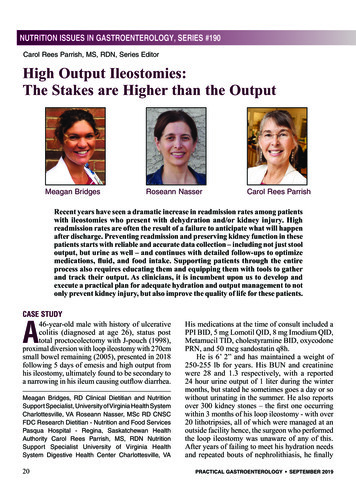

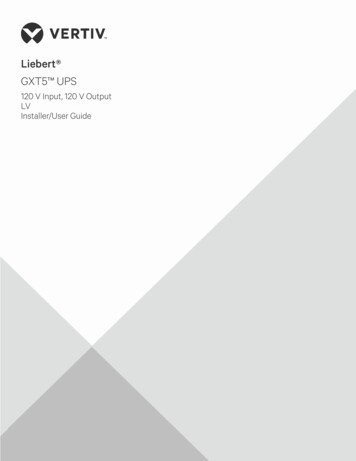
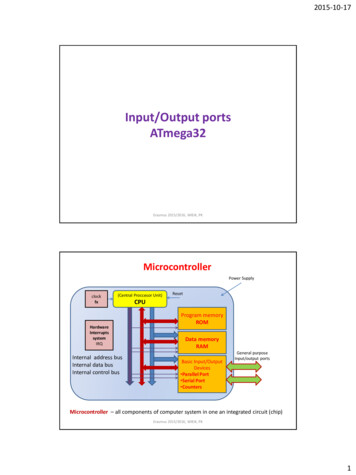
![Public Input No. 46-NFPA 70B-2016 [ Chapter 2 ]](/img/6/70b-f2018-eem-aaa-fd-piresponses.jpg)
